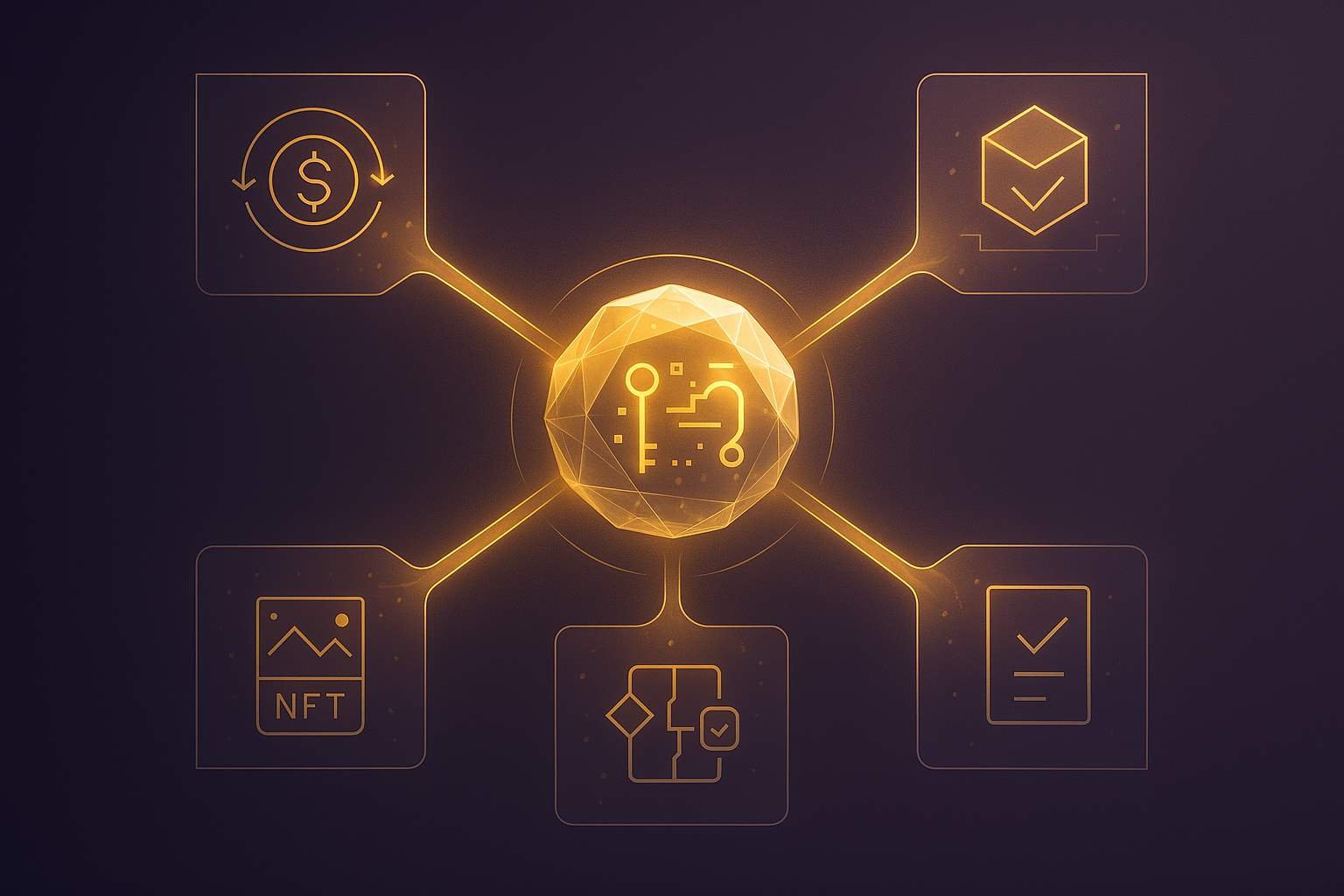Introduction to Blockchain Technology 📖
A blockchain is a decentralized, secure database that stores data across a network of computers, making it highly resistant to tampering.
Unlike traditional databases controlled by a single entity, a blockchain relies on a distributed network of computers, known as “nodes,” to validate and record transactions.
While blockchain is the foundation of cryptocurrencies, its applications extend far beyond, transforming industries like finance, supply chain, healthcare, and more.
Key benefits of blockchain technology include improved security and transparency, greater efficiency, cost savings, opportunities for innovation, and global accessibility.
Understanding Blockchain Technology 🔍
Blockchain technology is a decentralized system that securely stores data, verified by a network of computers, ensuring it cannot be easily altered.
Each block in a blockchain contains data and a unique identifier, cryptographically linked to the next block, forming a chain. This structure makes it nearly impossible to tamper with recorded data without altering the entire chain, which would require controlling the majority of the network.
The combined resources of nodes—whether through mining (proof-of-work) or staking (proof-of-stake)—enhance the security of blockchain networks, making them more resistant to attacks and ensuring data integrity.
This high level of security builds trust among users, especially in the crypto industry, where blockchain underpins decentralized finance (DeFi), smart contracts, and non-fungible tokens (NFTs).
Before exploring further, let’s break down the core characteristics of blockchain technology:
- Auditable: All data on the blockchain can be easily tracked and verified.
- Distributed: Blockchains are managed by a decentralized network, avoiding control by a single entity.
- Immutable: Once a transaction is recorded, it cannot be changed unless the majority of nodes agree, ensuring permanence.
Types of Blockchain Technology 📝
Blockchains vary depending on their structure and permissions, serving different industries and use cases. Here are the four main types:
- Public Blockchain: Open to everyone, these permissionless blockchains allow anyone to participate and make transactions. Examples include Bitcoin and Ethereum.
- Private Blockchain: Controlled by a single organization, these permissioned blockchains are often used for business applications requiring privacy.
- Hybrid Blockchain: Combines elements of public and private blockchains, with some parts open and others restricted for specific users.
- Consortium Blockchain: A type of private blockchain managed by a group of organizations that collaborate to validate transactions and maintain the network.
How Does Blockchain Technology Work? ⚙️
Imagine a blockchain as a series of digital blocks, each containing data, linked together in a chain using cryptography. The computers in the network, called nodes, manage, update, and verify this data.
Here’s the process in simple steps:
- A user initiates a transaction, which is broadcast to the blockchain network.
- Nodes verify the transaction, ensuring the sender has enough funds and isn’t attempting to double-spend.
- Once verified, the transaction is grouped with others into a new block.
- The block is added to the blockchain, creating a permanent, chronological record.
Blockchains achieve decentralization through consensus mechanisms, eliminating the need for a central authority. These mechanisms ensure all nodes agree on the validity of transactions. Developers design blockchain protocols with incentives—rewards for honest participation and penalties for malicious behavior—allowing the network to operate autonomously.
Key Components of Blockchain Technology 🧱
A blockchain consists of several critical elements that enable its functionality:
Cryptography
Blockchains use cryptography to secure data and transactions. Cryptography encrypts information, ensuring only authorized users can access it, even on a public network.
Historically used by military and intelligence agencies for secure communication, cryptography now plays a vital role in the crypto industry, protecting transactions and verifying ownership on public blockchains.
Distributed Ledger
A distributed ledger is a database shared across a network of nodes, offering an alternative to centralized systems. It reduces the risks associated with a single point of failure and gives users more control over their data, improving security and transparency.
Industries use distributed ledgers to streamline data sharing and record-keeping, enhancing efficiency and trust.
Consensus Mechanism
Consensus mechanisms are rules that ensure all nodes agree on the state of the blockchain and the validity of transactions. They prevent fraud, like double-spending, and maintain trust in a decentralized system.
The most common consensus mechanisms in crypto-focused blockchains are proof-of-work (PoW), used by Bitcoin, and proof-of-stake (PoS), used by Ethereum since its 2022 upgrade. Each mechanism incentivizes honest behavior and penalizes malicious actions.
Blockchain in Cryptocurrency 🤔
In the context of cryptocurrency, blockchain is the underlying technology that powers digital currencies like Bitcoin, Ethereum, and thousands of others.
Every crypto transaction is recorded on a blockchain, where it’s verified by a global network of independent nodes. This ensures transactions are secure, transparent, and traceable, preventing issues like double-spending or fraud.
The combination of cryptography and consensus mechanisms allows blockchains to operate without intermediaries, enabling trustless peer-to-peer transactions. This makes blockchain the backbone of the crypto industry, supporting everything from simple payments to complex DeFi applications.
Current and Future Applications of Blockchain 💭
Blockchain’s secure and immutable nature makes it a transformative technology for many industries. While some applications are already widely adopted, others are still in development.
Here are some notable use cases:
- Decentralized Cryptocurrencies: Blockchain’s original use case, enabling peer-to-peer digital currencies like Bitcoin (BTC) and USD Coin (USDC) for fast, intermediary-free transactions.
- Supply Chain Management: Blockchain improves transparency in supply chains by tracking goods across multiple systems. For example, IBM’s Food Trust uses blockchain to trace food products from farm to store.
- Healthcare Records: Blockchain can secure and share medical records, giving patients control over their data. Projects like Patientory and Medicalchain are exploring this space.
- Insurance: Blockchain reduces fraud and speeds up claims processing. For instance, in 2024, InsureChain launched a blockchain platform for property insurance, used by companies like Allianz.
- Energy Sector: Blockchain enables peer-to-peer energy trading and renewable energy integration. Power Ledger (POWR) allows users to trade solar energy and carbon credits.
- Identity Management: Blockchain offers secure identity verification. The SelfKey project provides a blockchain-based identity system for managing personal data.
- Voting Systems: Blockchain can enhance election security and transparency. Voatz has piloted blockchain-based voting in U.S. local elections.
- Item Authentication: Beyond NFTs, blockchain verifies the authenticity of physical goods. The VeChain project tracks luxury goods to prevent counterfeiting.
Benefits of Blockchain Technology ✅
Blockchain offers significant advantages across industries:
- Enhanced Security and Transparency: Transactions are immutable, ensuring data integrity, and the decentralized design resists fraud. The public ledger allows anyone to verify transactions, building trust.
- Increased Efficiency and Cost Savings: By removing intermediaries and automating processes with smart contracts, blockchain reduces costs and speeds up transactions.
- Potential for Innovation: Blockchain enables new technologies like smart contracts and dApps, as well as tokenization of real-world assets, creating innovative business models.
- Global Accessibility and Scalability: Anyone with internet access can use blockchain networks, facilitating fast global transactions. Advances like Layer 2 solutions (e.g., Arbitrum, Lightning Network) improve scalability for broader adoption.
How to Invest in Blockchain Technology 🧑💻
Investing in blockchain can take various forms based on your goals and risk tolerance:
- Buy Cryptocurrencies: Purchase tokens like Bitcoin or Ethereum on trusted platforms. Always research thoroughly and only invest what you can afford to lose.
- Invest in Blockchain Companies or ETFs: Consider stocks of companies developing blockchain solutions or ETFs (e.g., Bitwise DeFi Crypto Index) for broader exposure.
- Do Your Research: Understanding the technology and market trends is crucial for informed decisions.
At CryptoAnalyzes, we’re here to help you navigate the crypto world with confidence. For VIP analysis services, in-depth trading insights, and personalized strategies, visit Cryptoanalyzes. Want to explore more educational content? Check out our CryptoAnalyzes blog for the latest articles.




















